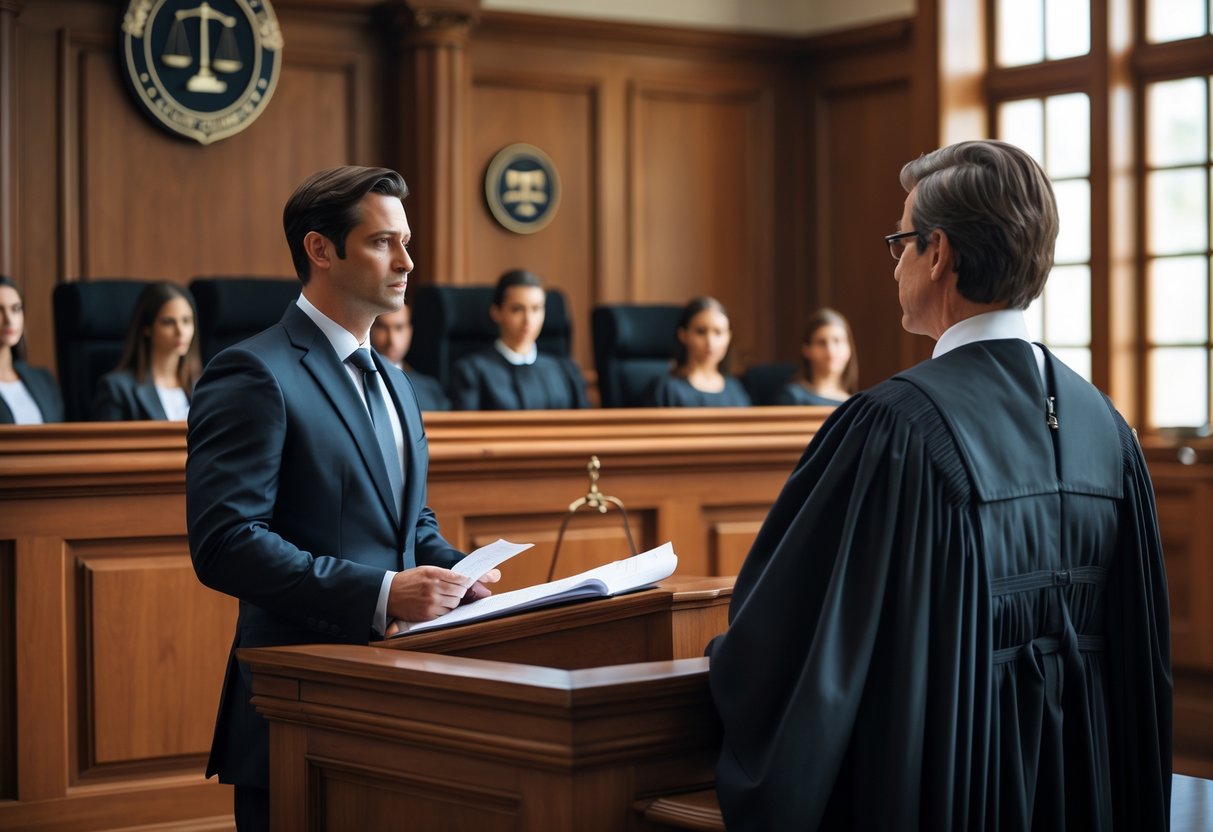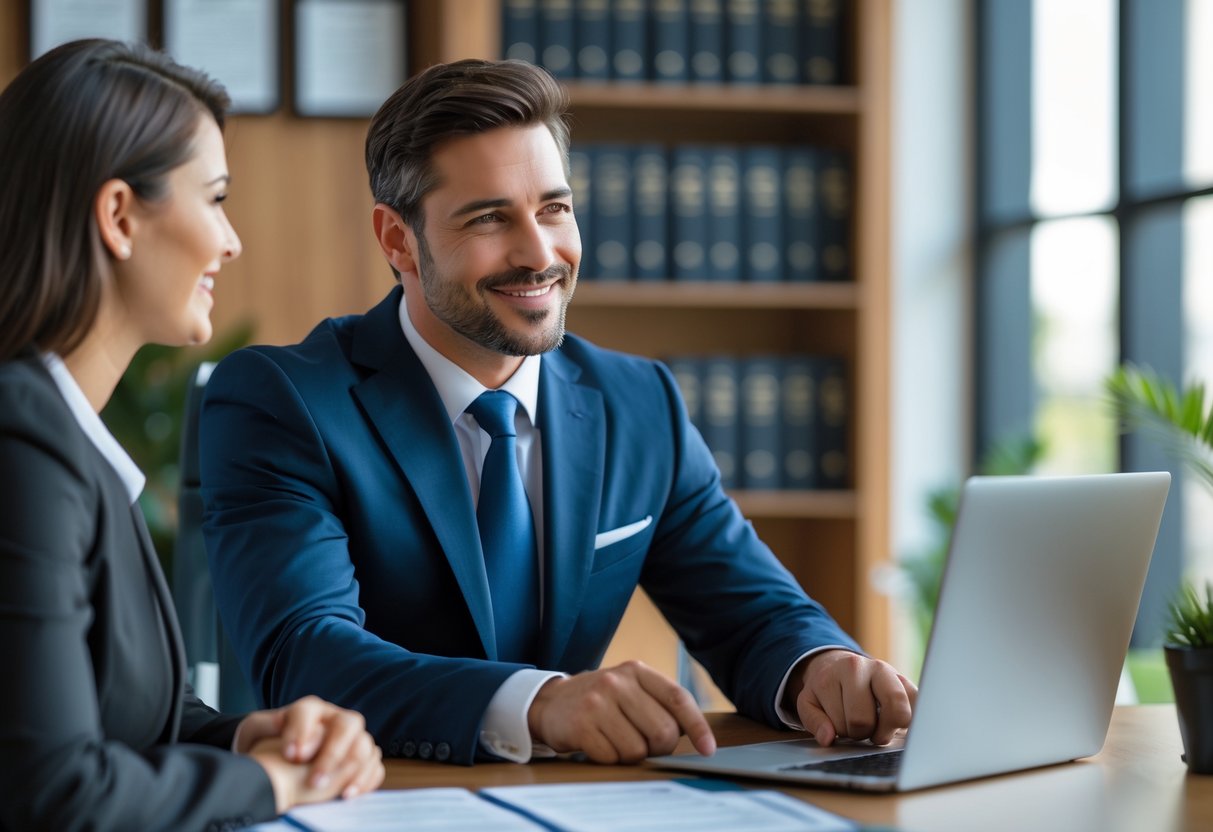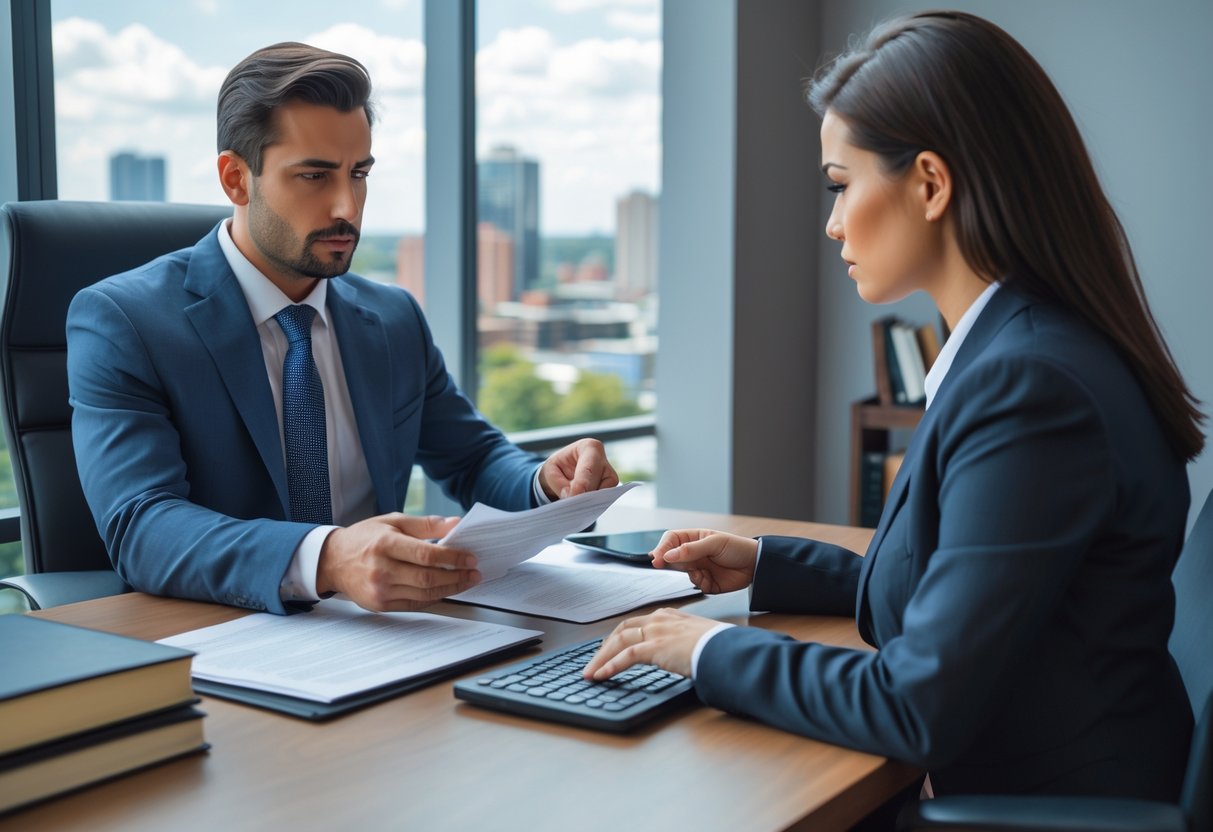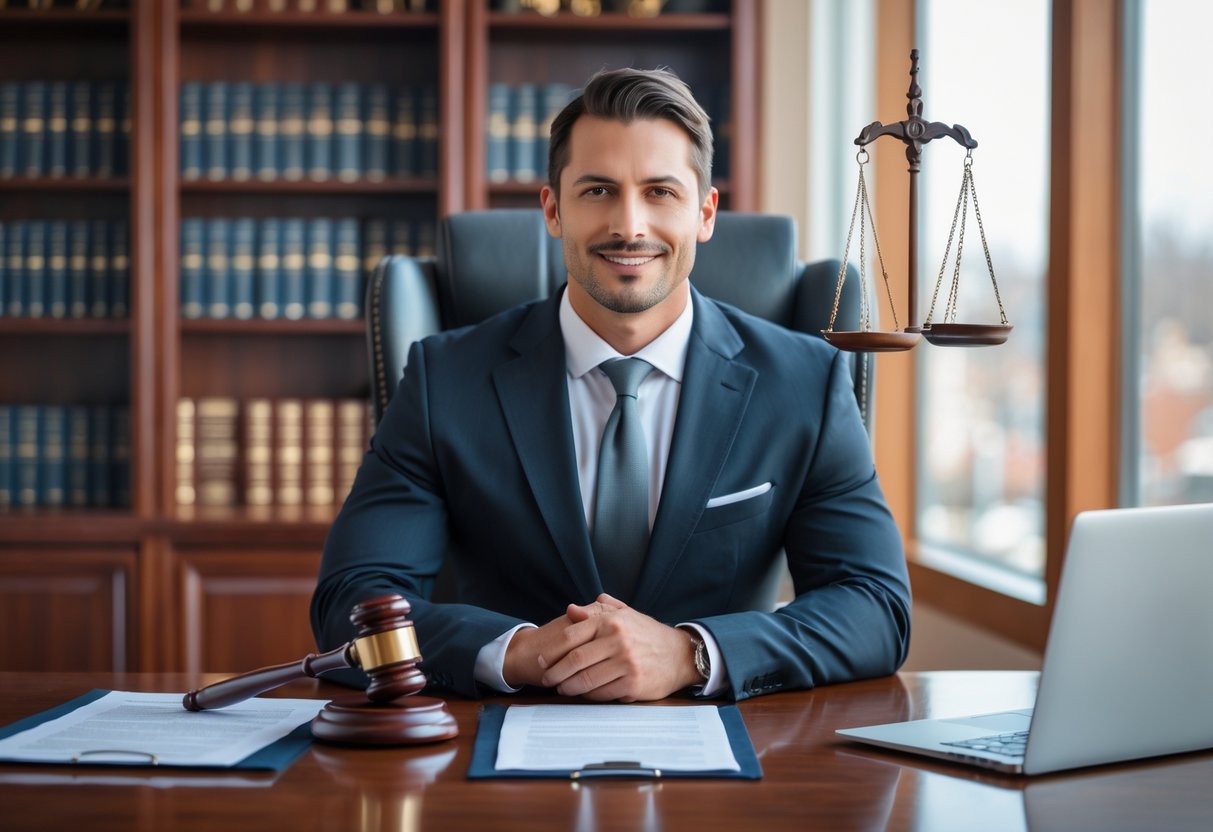When we watch a criminal trial, the opening statements often set the stage for everything that follows. Many of us may not realize how much these first words shape what the jury thinks about the case. Understanding opening statements in criminal cases helps us make sense of the trial and see why each side chooses certain words and facts to focus on.
An opening statement gives us a guide to what both the prosecution and the defense believe happened. We get to hear their main points and learn what evidence they plan to show. This first look can help us follow along and understand each step of the trial.
Purpose of Opening Statements in Criminal Cases

Opening statements are a key part of every criminal trial. They help the jury understand the main facts, introduce the people involved, and set the stage for the evidence that will follow.
Definition and Role
An opening statement is the first chance for lawyers to talk directly to the jury. Each side presents its view of what the trial will show. The prosecution goes first, followed by the defense.
In opening statements, lawyers do not argue or present actual evidence. Instead, they outline which facts they believe will come out during the trial. This helps us know what to pay attention to as the case develops.
The role of the opening statement is to act as a roadmap for the trial. It introduces key people, explains important events, and hints at the main evidence. It should be clear, organized, and focused on what will later appear in testimony and documents.
Purpose of Opening Statements
Opening statements serve several purposes in criminal cases. One main goal is to help the jury understand the charges and how the law applies. This gives context so the jury can follow along as witnesses and evidence are presented.
Another purpose is to tell a basic story of what each side believes happened. The prosecution often explains how the crime took place and what evidence will support their position. The defense may suggest doubts about the facts, highlight problems in the evidence, or state their own version of events.
By laying out expectations, opening statements make it easier for us to follow the case. The jury uses this information to organize what they learn later. A good opening statement is not about emotion or drama, it is about helping us understand.
Distinction from Closing Arguments
Opening statements and closing arguments are two separate trial parts with different rules. In the opening statement, lawyers describe what the evidence will show, but they are not allowed to make arguments or state their own opinions.
Closing arguments come at the end of the trial. That is when lawyers argue about what the evidence means, try to persuade the jury, and point out the strengths and weaknesses of the case.
The table below compares these two parts:
| Aspect | Opening Statement | Closing Argument |
|---|---|---|
| When in Trial | Beginning | End |
| Purpose | Preview evidence | Argue meaning of evidence |
| Allowed to Argue | No | Yes |
| Focus | Facts to be presented | Interpreting those facts |
Keeping this distinction clear helps us understand what to expect at each step of the trial.
Structure of Opening Statements

Opening statements in a criminal case set the stage for the trial. We need to understand the rules, required parts, and how lawyers use this time to lay out their side to the jury.
Key Components
Opening statements usually include several important parts:
- Introduction: Lawyers introduce themselves, their client, and the basic idea of the case.
- Background Facts: This section gives the facts as the lawyer expects the evidence will show.
- Themes and Theories: Lawyers highlight main ideas or themes, such as “self-defense.”
- Key Evidence: They may mention important witnesses or pieces of evidence the jury will hear about during the trial.
- Request to Listen Carefully: Lawyers often ask the jury to pay attention to the evidence.
Each part helps the jury follow the case and understand what each side plans to prove or disprove.
Legal Standards Governing Opening Statements
There are rules that limit what lawyers can say during opening statements. We are not allowed to make arguments or state our personal opinions at this stage.
Lawyers must only mention the facts they expect to prove with evidence. We cannot discuss anything that will not be shown by the evidence in court.
The judge may stop the opening statement if the lawyer goes too far, such as by arguing guilt or mentioning excluded evidence. Legal standards keep the opening statement focused only on what the jury should consider.
Order and Presentation
In a criminal case, the structure of the opening statement usually follows a set order. The prosecution always goes first because they have the burden of proof.
The defense can choose to present right after the prosecution or wait until after the prosecution has finished its case. This order is important since it shapes how the jury hears the case for the first time.
Opening statements should be clear and well-organized. Lawyers often use outlines or simple stories, avoiding confusing language or too much detail.
Introduction Versus Roadmap
The introduction of the opening statement is brief. We use it to greet the jury, introduce ourselves and our client, and give a short overview of what our case is about.
A roadmap goes further. Here, we outline what the jury can expect, including what evidence will be shown and which witnesses will testify.
The roadmap serves as a guide for the jury. It helps them know what to look for and how the pieces of the case fit together. By using both an introduction and a roadmap, we keep the jury engaged and prepared for what is to come.
The Roles of Prosecution and Defense
In a criminal trial, both the prosecution and defense present opening statements to explain their positions. These statements set the stage for what the judge and jury can expect to hear throughout the criminal procedure.
Prosecutor’s Opening Statement
The prosecutor speaks first during opening statements. Their main job is to lay out the criminal charges and give the jury a clear idea of the evidence they plan to present. We see the prosecutor outline the facts, describe the key events, and mention important witnesses.
Prosecutors must stick to facts and cannot argue or give opinions at this stage. They usually follow a logical order, making it easier for us to understand the case against the defendant.
It’s common for prosecutors to use simple language and graphics, like charts or timelines, to help the jury follow along. They focus on making their case seem clear and believable without getting emotional or dramatic.
Defense Attorney’s Opening Statement
After the prosecutor finishes, the defense attorney or defense lawyer gives their opening statement. This is their chance to tell us the other side of the story. Sometimes, the defense may wait to give their statement until after the prosecution has presented its evidence.
The defense often points out gaps or weaknesses in the prosecution’s case. They may offer an alternative explanation of the events or directly challenge the criminal charges. Like prosecutors, defense lawyers must only talk about facts they expect the evidence to show, not their personal opinions.
Defense attorneys usually work to make the jury understand that the defendant is presumed innocent. They explain why, based on the facts, there might be reasonable doubt about guilt. This helps prepare the jury to view the upcoming evidence with an open mind.
Crafting Effective Opening Statements
Strong opening statements help us set the tone and shape how jurors see our case. By combining clear storytelling, the right emotional tone, and confident delivery, we can capture attention and support our argument.
Persuasive Narrative and Storytelling Techniques
We need to present our facts as a story. Jurors respond best to information when it is clear and organized, so we should put events in order and explain the main points step by step.
- Clear introduction of people and events
- A logical timeline
- Simple, direct language
When we use storytelling techniques, such as focusing on important details and repeating key themes, jurors can follow and remember what we say. It also helps if we keep our message focused and avoid side issues that might distract from our main goals.
Rhetorical Strategies and Emotional Appeal
Our words can be powerful tools. Using rhetorical strategies like repetition, statistics, and carefully chosen questions can help us get our point across. For example, we might use repetition for vital facts, or contrasts to show differences between our side and the other side.
We should also consider how our words can connect emotionally. When we use relatable language or talk about feelings like fear, anger, or hope, we may help jurors understand why our case matters. However, it is important to keep our language respectful and not try to mislead or use too much emotion, or we risk losing juror trust.
Effective Communication and Body Language
How we speak and act in front of a jury matters. Effective communication means using a steady, clear voice and making eye contact with jurors. This shows we are honest and believe in our case.
We should pay attention to our body language:
- Open posture (no crossed arms)
- Standing still and facing the jury
- Nodding to show understanding
Small cues such as gestures and looking at jurors as we speak help us build a connection. If we look nervous or shift our feet too much, jurors may become distracted, so it is best to practice calm and careful movements.
Presenting Evidence and Legal Arguments
At trial, we focus on rules about what proof is allowed and how lawyers explain the law. The trial process depends on showing solid evidence and making arguments that fit the facts and the law.
Admissible Evidence and Key Evidence
Not all proof can be shown in court. We must use admissible evidence, which means it meets court rules. These rules keep out things that are unfair, unreliable, or confusing. Common admissible evidence includes:
- Witness testimony (what people saw or heard)
- Documents (emails, reports, contracts)
- Physical objects (weapons, clothing)
- Photos and videos
Key evidence is what supports one side’s case the most. For example, a fingerprint at the crime scene, a video of the event, or DNA could be key. The judge decides which evidence is admissible before or during the trial. Evidence that is not allowed, such as rumors or irrelevant details, gets excluded.
Legal Arguments and Legal Theories
Lawyers do not just present facts; they connect those facts to laws. They use legal arguments to show why the law supports their side. These arguments explain what crime may have happened, who did what, and what law applies.
A legal theory is how lawyers say the event fits under the law. For example, a defense lawyer might argue that the accused acted in self-defense. A prosecutor might claim the accused planned the crime. Our legal arguments must match the evidence we show.
Making clear legal arguments helps the jury or judge understand why our evidence is important. It also gives the other side a chance to respond.
Roadmap for the Trial
A trial has a clear process. Evidence and arguments are presented in a set order to help everyone follow what is happening. Here is a simple roadmap:
- Opening statements
- Evidence presentation—prosecution first, then defense
- Cross-examination of witnesses
- Closing arguments
- Jury instructions (if there is a jury)
- Verdict
We use this structure so jurors can link the evidence to the legal arguments. Keeping the steps organized helps everyone remember the big points as the trial moves forward. We always try to be clear about how each part fits into the trial process.
Burden of Proof and Reasonable Doubt
In criminal cases, the responsibility for proving guilt lies with the prosecution. The law requires that the evidence meet a very high standard before someone can be convicted.
Explaining Burden of Proof
The burden of proof means that the government must show, through evidence, that the defendant committed the crime. It’s not the responsibility of the accused person to prove they are innocent.
Prosecutors must bring facts, witnesses, or physical evidence to support their claims. If they do not meet this burden, the case should not move forward.
This rule protects us all. It ensures that people are only convicted if the evidence is clear and convincing. It also means that a person does not need to say or do anything to prove they did not commit the crime.
Concept of Reasonable Doubt
Reasonable doubt is the highest level of proof in the legal system. The jury can only find a person guilty if they are sure, based on the evidence, that the defendant committed the crime.
We cannot convict someone if there is a real question in our minds about their guilt. Reasonable doubt does not mean absolute certainty. It means that, after looking at all the evidence, there are no logical reasons left to doubt the person’s guilt.
If any juror has a reasonable doubt, they must find the defendant not guilty. This helps prevent innocent people from being punished.
Not Guilty and Self-Defense
A verdict of not guilty means the prosecution did not prove its case beyond a reasonable doubt. It does not always mean the defendant is innocent, but it does mean the government’s evidence fell short.
In some cases, the defense may argue self-defense. Here, the defendant admits to the action but claims it was necessary to protect themselves. We must still look closely at the evidence. The prosecution must prove beyond a reasonable doubt that self-defense does not apply.
If jurors believe self-defense is possible, this can create reasonable doubt, which means they must find the defendant not guilty. This respects the idea that nobody should be unfairly convicted or punished.
Impact on Jury Perception
Opening statements shape how jurors see the evidence and the people in the courtroom. These early impressions can affect what jurors remember and how seriously they take each side’s arguments.
Credibility and Jury Perceptions
Jurors tend to pay close attention to how lawyers present themselves. If we appear organized and prepared during our opening statement, jurors may see us as more credible. This credibility makes them more likely to trust our version of events.
A lawyer’s tone, choice of words, and ability to stick to facts matter a lot. If we exaggerate or make promises the evidence does not support, jurors may begin to doubt us later in the trial. Clarity and honesty in our statements help foster confidence in our case.
Jurors can quickly form opinions about which lawyer seems more trustworthy. These opinions sometimes last through the rest of the trial. For this reason, our first impression has a strong impact on jury perception and their attitude toward our arguments.
Influence of Body Language and Eye Contact
The way we carry ourselves in court can affect how jurors view us. Good body language such as standing up straight and facing the jury shows confidence. Jurors may feel more engaged when we maintain proper posture and avoid nervous gestures.
Eye contact is also important. When we look at the jurors while speaking, it helps build a connection and shows respect. Too little eye contact may make us seem dishonest or unsure.
The small details, like hand movements and facial expressions, can change the way jurors react to what we say. Positive body language and steady eye contact make it more likely for jurors to pay attention and trust our statements.
Common Mistakes and Ethical Considerations
Strong opening statements can help a case, but mistakes and ethical lapses can harm a lawyer’s credibility. We must follow the rules and avoid errors that could cause delays, objections, or even a mistrial.
Common Mistakes in Opening Statements
Many lawyers try to argue the case or give their opinion. Opening statements should only tell the jury what we expect the evidence will show. We should never make promises about evidence that we know may not be introduced.
It is a mistake to exaggerate or use emotional language. This confuses the jury and could make us look untrustworthy. Listing facts is better than telling a dramatic story.
Reading from notes for too long can make us seem unprepared. Repeating information or focusing too much on small details is also a common problem.
| Mistake Type | Example |
|---|---|
| Making Arguments | “The defendant is clearly guilty.” |
| Overpromising | “We will show X,” but can’t prove |
| Emotional Appeals | “This was a tragedy—think of… “ |
| Lack of Clarity | Wandering or unclear statements |
Objections and Mistrial
If an attorney crosses a line, the opposing side may object. Common reasons for objection in opening statements include:
- Arguing instead of explaining anticipated evidence
- Mentioning excluded evidence
- Showing personal belief/opinion
Frequent or serious mistakes can lead to the judge warning the lawyer or even declaring a mistrial. A mistrial means the case stops and may need to start over, which wastes everyone’s time and resources.
We must watch our words closely. If objections happen often, the jury may think we are not following the rules, which could hurt our case.
Ethical Standards and Ethical Considerations
We follow strict ethical standards set by law and organizations like the American Bar Association. We must be honest about what the evidence will show. We cannot trick or mislead the jury with false facts or hidden information.
It is unethical to reference evidence we know will not be admitted. ABA Model Rules require us to present statements in good faith. We avoid using private facts, gossip, or anything likely to prejudice the jury.
Maintaining trust is part of our duty. Breaking ethical rules can lead to disciplinary action or even loss of our license.
Personal Opinion and Boundaries
We are not allowed to share our own feelings or beliefs about guilt or innocence in opening statements. Personal opinion is not evidence and is strictly forbidden.
The rules set boundaries to protect the trial’s fairness. Any statement starting with “I believe…” or “I think…” is not allowed. Instead, we focus on what witnesses will testify or what the evidence will show.
Crossing these boundaries can lead to objections, loss of jury trust, and ethical complaints. Sticking to facts protects both our integrity and the rights of all parties.
Strategic Approaches for Opening Statements
A strong opening statement sets the direction for our case. We must plan carefully to make a connection with the jury, face any weaknesses, and show how our future evidence will fit together.
Tailoring Strategies for the Jury
We need to learn about the jury during voir dire and jury selection. By observing jurors’ backgrounds, attitudes, and responses, we can adjust our opening statements to connect with them.
If our jury includes teachers, we may use simple examples for complex ideas. If we see jurors care about fairness, we focus on facts that support justice and responsibility.
Checklist for connecting with jurors:
- Use language they understand
- Avoid legal jargon
- Highlight big points early
- Relate facts to daily life
By keeping our words relatable, we make it easier for jurors to follow our case.
Addressing Weaknesses in the Case
Ignoring weaknesses lets the other side surprise us later. Instead, we bring up any weak spots ourselves and explain them directly.
For example, if a witness has a past mistake, we admit it and explain why it does not change our story. If some evidence is missing, we give a clear reason. This builds trust with the jury.
- Admit flaws up front
- Explain or offer context
- Stay honest and confident
Facing problems head-on helps us keep control of our case’s story.
Incorporating Trial Testimony
We preview what our witnesses will say so the jury knows what to expect. We describe the main facts each witness will cover, without giving too much detail.
Our goal is to show the jury how each piece of testimony fits the bigger picture. This helps jurors follow along as the trial continues.
Sample approach:
- Introduce each main witness
- Briefly state what that witness will explain
- Remind the jury how it connects to our case’s main issue
By mapping out the trial testimony early, we help jurors remember and understand each witness’s role and importance.
Notable Opening Statements in Criminal Cases
Famous criminal cases often feature opening statements that shape the course of the trial. These statements can give us unique insights into both legal strategies and jury persuasion techniques.
Historical Examples
Throughout history, we find opening statements that have become well-known for their impact. In the O.J. Simpson trial, the defense’s opening statement set a tone of doubt and asked the jury to focus on potential police mistakes. This approach was memorable because it challenged the evidence from the very beginning.
Another example is the opening statement in the 1935 trial of Bruno Hauptmann for the Lindbergh kidnapping. The prosecutor’s words outlined the facts in clear, simple language, making the case easy for the jury to follow.
These examples show how attorneys use opening statements to outline their theory of the case and signal their main arguments. Strong opening statements do not just present the facts they organize the story that the jury will hear.
Lessons from Landmark Trials
When we look at lessons from landmark criminal cases, several patterns emerge in effective opening statements. Clear and organized statements help jurors know what to expect. For example, in the trial of Ted Bundy, the prosecution’s opening was direct, walking the jury through the main evidence and what it meant.
Attorneys also build trust with jurors during their opening statements by sticking to facts, avoiding too many promises, and speaking simply. In high-profile cases like the Casey Anthony trial, both sides used their opening statements to lay a foundation for their closing statements, forecasting how they planned to pull all the evidence together at the end.
A good opening statement gives the jury a roadmap, setting them up for the rest of the trial. We see this in many historic and modern criminal cases.




